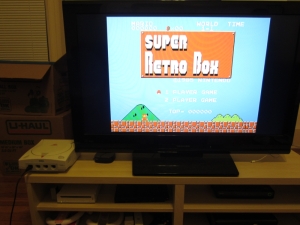Here is the finished product hooked up to the TV.
And it works!
Here you can see my beautiful custom loading screen which I definitely did not put too much time into making.
And that finishes things up. I have some more software tweaks I want to make, such as setting up an automated system that backs things up to my Linux server, but the hardware portion is now done.


Really fun to watch this come to fruition. Good Job!
LikeLike
So cool!
I just recently found out about the one card computing community, and it really is awesome! Had plans to do a (first time attempt) pc-build in a console, like the xbox or nes, but this is perfect since i own two Dreamcast, one broken 🙂 This is great! You really did what i want to do, and really nice looking i might say, with my derived Swedish-English! Jävligt coolt, as we say!
My question to you is, wich skills and knowledge is required to do one of these builds? Basic soldering, Basic computing skills like formatting an sdcard, tweaking and trial and error? But other than that? Do you need to understand code? Cause i don’t.
Please forgive my intrusion, and feel free to answear.
Have a great day! Regards Manny from Sweden 🙂
LikeLike
Thanks for the complement.
On the hardware side it mainly just takes basic soldering skills.
The software side is pretty simple thanks to the RetroPie software I used. They offer an SD card image that you can download. You can boot it, make some minor settings changes, and push ROMs to it. This Lifehacker article does a good job going over the basics: http://lifehacker.com/how-to-turn-your-raspberry-pi-into-a-retro-game-console-498561192
If the default settings don’t work for you then there may be some system/RetroPie adjustments you have to make. Linux knowledge is helpful in this area. The RetroPie website has a forum with some good info on tweaking the system: http://blog.petrockblock.com
LikeLike
Thank you Kevin!
Well that that’s great news. This onecard scene isn’t big in sweden for all I know, so those links you posted will be of value, least to say!
The only code i ever tried to understand and write was some phyton-spinoff used in Rpgmaker. I’d rather have someone else do most of it 😉
I’m picking up the pi2 immediately. Thanks again for your help and the inspiration.
Have a great one/ Manny 🙂
LikeLike